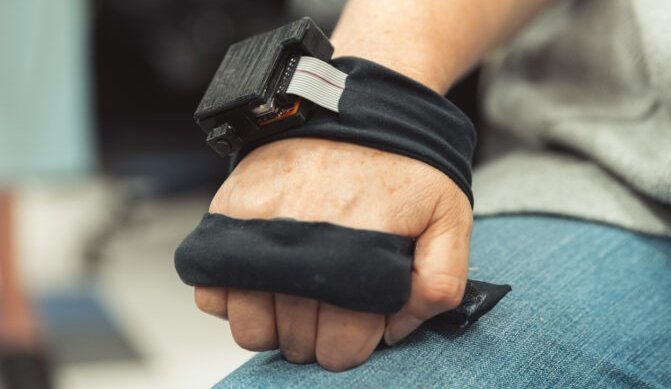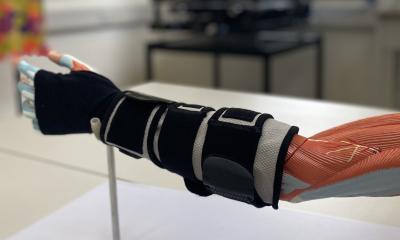
Image credit: Stanford/Andrew Brodhead
News • Wearable medical device
Vibrating glove helps stroke patients recover from muscle spasms
For those with stroke, involuntary contractions of the hands and arms often follow. A simple, wearable vibrating glove may offer a more effective treatment.
After a stroke, survivors often experience uncontrollable spasms that can twist their arms and hands into perpetual fists. The only treatments are expensive, frequently painful injections of botulinum toxin or oral medications so strong they may put patients to sleep. Both offer only temporary relief. Engineers at Stanford University and the Georgia Institute of Technology now say they have developed a glove-like wearable medical device that achieves as good or better results as the injections or drugs by applying simple, high-frequency mechanical vibrations to the hands and fingers.
Their research results are published in the journals Frontiers in Human Neuroscience and Archives of Physical Medicine and Rehabilitation.
We think it can potentially address several effects of stroke – numbness, spasticity, and, for some, limited range of motion
Caitlyn Seim
“Vibration therapies are not unknown, so we knew we would see some effect, but clinically it was just amazing to see that these beneficial effects persist,” explained Allison Okamura, the Richard W. Weiland Professor in the Stanford School of Engineering and senior author of a series of studies introducing the glove. “There are significant improvements in symptoms using the simulation method. And we think it can potentially address several effects of stroke – numbness, spasticity, and, for some, limited range of motion,” said Caitlyn Seim, a postdoctoral researcher in Okamura’s lab and initiator of the project. “We’re most excited about treating spasticity because it affects so many people’s quality of life and has such limited treatment options.”
To the researchers’ knowledge, this is the first effort to explore vibrotactile stimulation (VTS) technique at a wearable scale. State-of-the-art methods employ whole-body vibration using machines that are large, expensive, and require visits to the clinic for treatment.
Recommended article

News • Research, diagnostics, therapies
Focus on stroke
Strokes are among the most common cause of death worldwide and one of the most common causes of disability. Mortality rates are decreasing due to improving care. Nevertheless, experts expect the absolute number of cases to rise in view of the ageing population. Read more about current research and treatment options here.
Patients in trials wore the VTS device three hours a day for eight weeks. Results were compared to the effectiveness of injections and oral medications. When measured, more than half of the participants who received regular botulinum injections had equal or better results with daily use of the VTS glove. “I think we can safely say that VTS is at least as good as injections and oral medicines,” Okamura said. “And it was exciting to see there is some maintenance of the improvements over time, though more study of that is needed.”
The prototype device was first developed by Seim and colleagues at Georgia Tech as a tool to help people learn motor tasks such as typing or playing musical instruments via haptic guidance. The device was later studied as an interactive music exercise tool for people with partial spinal cord injuries, which led the team to the realization that haptic stimulation may be therapeutic on its own. Their unique wearable form factor makes a new paradigm in intensive stimulation therapy possible since users can wear the gloves throughout the day. “We started to wonder if stimulation might also be a therapeutic tool for brain and spinal injury. It was very exciting,” Seim said.
The brain is essentially relearning the ability to perceive touch and proprioception
Caitlyn Seim
The latest version of the VTS device wraps around the wrist, palm, and fingers and includes motors that provide continual high-frequency stimulation to individual fingers as well as muscles in the hand and wrist. The vibrations are subtle and unobtrusive – similar to the intensity of a cell phone vibrating. Patients are free to go about their normal activities while wearing the device.
Neurologically, the mechanisms underlying the symptom improvements are still being studied, but the team theorizes that the device is taking advantage of the brain’s remarkable plasticity – its ability to find new pathways in response to damage or dysfunction. They believe that the VTS vibrations can modulate out-of-control muscles and send neural signals from the muscles back to the brain where the signals re-train undamaged areas of the brain. “The brain is essentially relearning the ability to perceive touch and proprioception,” Seim said of the brain’s ability to feel and understand where and how the arm, hands, and fingers are positioned in three-dimensional space.
Both researchers say they believe VTS might also prove effective in other brain injury-related motor conditions and diseases – areas the team is already pursuing as they explore stroke effectiveness. “There are currently 100 million people worldwide living with stroke,” Seim said. “As many as one-third experience these paralyzing arm spasms. We targeted the largest possible population first, but certainly, other conditions are on our radar.”
As of now, the VTS device is available only to patients in the clinical trial, and Okamura and Seim are gearing up for the next phases which will include additional clinical studies to understand the device’s long-term effectiveness and optimal design. To that end, the team recently received a considerable grant from the National Science Foundation’s Convergence Accelerator program to further develop the vibrotactile glove as a commercial product. “We think we have enough clinical study under our belt to know that VTS is a very safe, effective treatment,” Okamura said. “We’d love to start getting it out there as a publicly available therapy.”
Source: Stanford University
15.02.2024











